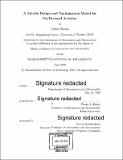| dc.contributor.advisor | Wesley L. Harris. | en_US |
| dc.contributor.author | Brown, Arthur (Aeronautics scientist) Massachusetts Institute of Technology | en_US |
| dc.contributor.other | Massachusetts Institute of Technology. Department of Aeronautics and Astronautics. | en_US |
| dc.date.accessioned | 2018-11-28T15:41:47Z | |
| dc.date.available | 2018-11-28T15:41:47Z | |
| dc.date.copyright | 2018 | en_US |
| dc.date.issued | 2018 | en_US |
| dc.identifier.uri | http://hdl.handle.net/1721.1/119293 | |
| dc.description | Thesis: S.M., Massachusetts Institute of Technology, Department of Aeronautics and Astronautics, 2018. | en_US |
| dc.description | Cataloged from PDF version of thesis. | en_US |
| dc.description | Includes bibliographical references (pages 145-152). | en_US |
| dc.description.abstract | On-demand aviation refers to an envisaged air taxi service, using small, autonomous, vertical-takeoff-and-landing, battery-powered electric aircraft. A conceptual design and optimization tool for on-demand aviation is presented in this thesis. The tool uses Geometric Programming, a class of optimization problems with extremely fast solve times and for which global optimality is guaranteed. The optimization model consists of a vehicle, a sizing mission, a revenue-generating mission, and a deadhead (non-passenger-carrying) mission. Cost per trip, including the additional cost due to the deadhead mission, is used as the objective function. Vehicle noise is computed during post-processing using a semi-empirical method. The tool is used to conduct a study of on-demand aviation from a vehicle design perspective. A trade study is conducted between several different on-demand aircraft configurations. Four configurations are viable: the lift + cruise configuration, the compound helicopter, the tilt wing, and the tilt rotor. Configurations with a higher lift-to-drag ratio, but a higher disk loading, generally weigh less and cost less to operate; configurations with a lower lift-to-drag ratio, but a lower disk loading, are quieter. Using New York City as an example market, it is shown that an on-demand air service will cost significantly less as compared to current helicopter air taxi operations. The two most important costs are pilot salary and battery amortization. If these two costs can be reduced (via vehicle automation and reduced battery manufacturing costs respectively), an on-demand air service becomes competitive with current car ridesharing on the basis of cost per seat mile. Therefore, on-demand aviation has the potential to become a system for everyday commutes. Technological assumptions and vehicle requirements, especially mission range, battery energy density, vehicle autonomy level, battery manufacturing cost, and reserve requirements, have significant impacts on vehicle weight and cost. Vehicle noise can be reduced through the careful selection of key design parameters. However, envisaged noise requirements cannot easily be met, even with the most generous long-term technological assumptions. Vehicle noise is therefore a critical issue for on-demand aviation; substantial engineering effort to reduce noise will be required. | en_US |
| dc.description.sponsorship | Funded in part by the Arthur Gelb graduate fellowship Funded in part by AIAA William T. Piper, Sr. General Aviation Systems Graduate Award | en_US |
| dc.description.statementofresponsibility | by Arthur Brown. | en_US |
| dc.format.extent | 152 pages | en_US |
| dc.language.iso | eng | en_US |
| dc.publisher | Massachusetts Institute of Technology | en_US |
| dc.rights | MIT theses are protected by copyright. They may be viewed, downloaded, or printed from this source but further reproduction or distribution in any format is prohibited without written permission. | en_US |
| dc.rights.uri | http://dspace.mit.edu/handle/1721.1/7582 | en_US |
| dc.subject | Aeronautics and Astronautics. | en_US |
| dc.title | A vehicle design and optimization model for on-demand aviation | en_US |
| dc.type | Thesis | en_US |
| dc.description.degree | S.M. | en_US |
| dc.contributor.department | Massachusetts Institute of Technology. Department of Aeronautics and Astronautics | |
| dc.identifier.oclc | 1061558926 | en_US |
